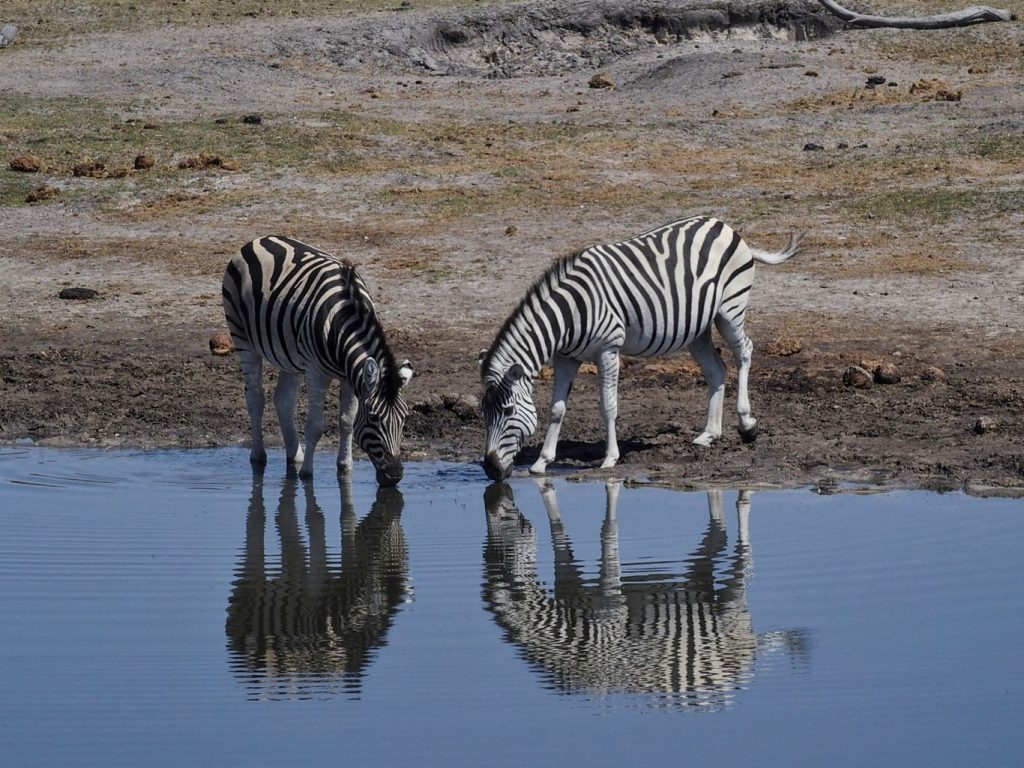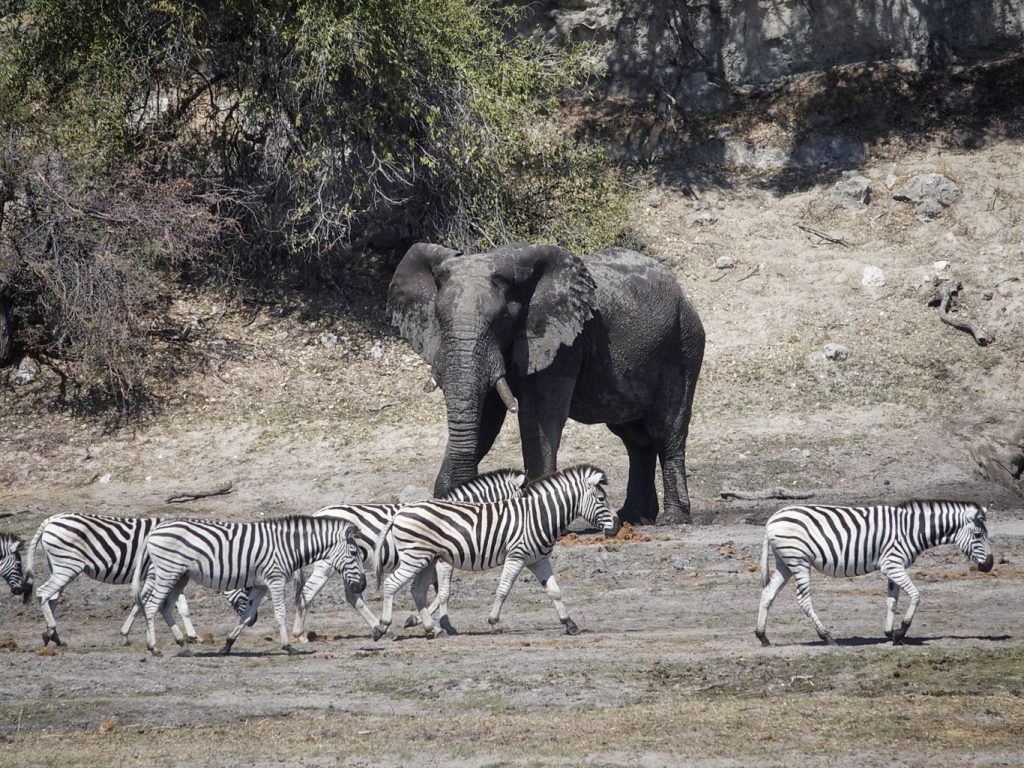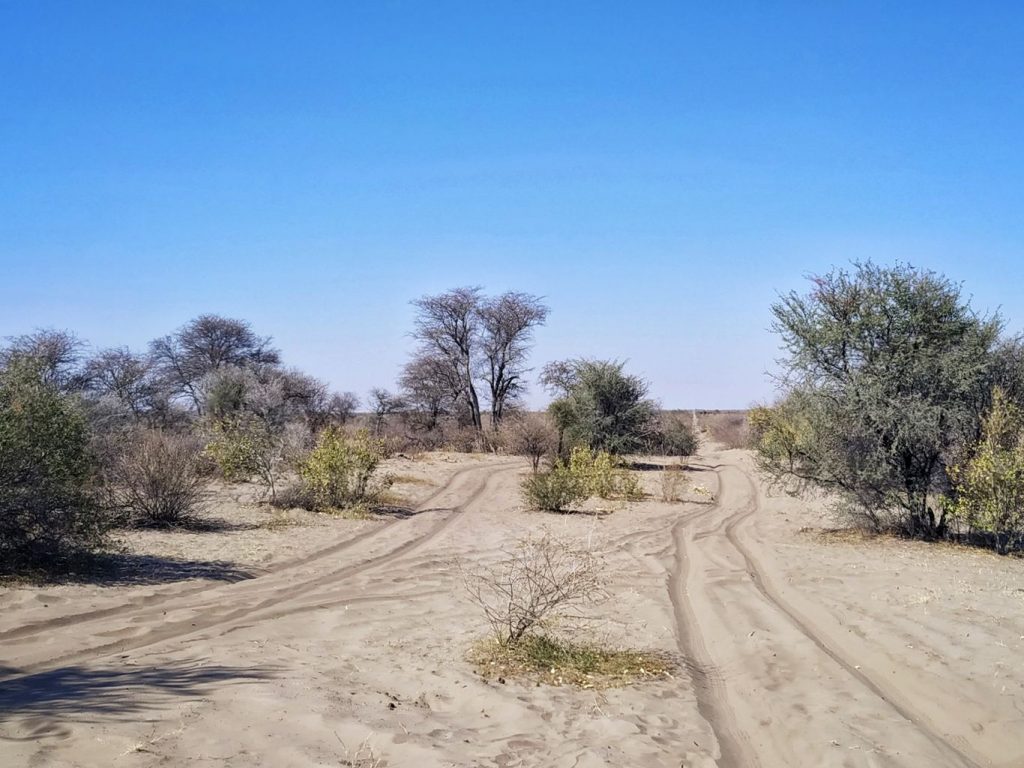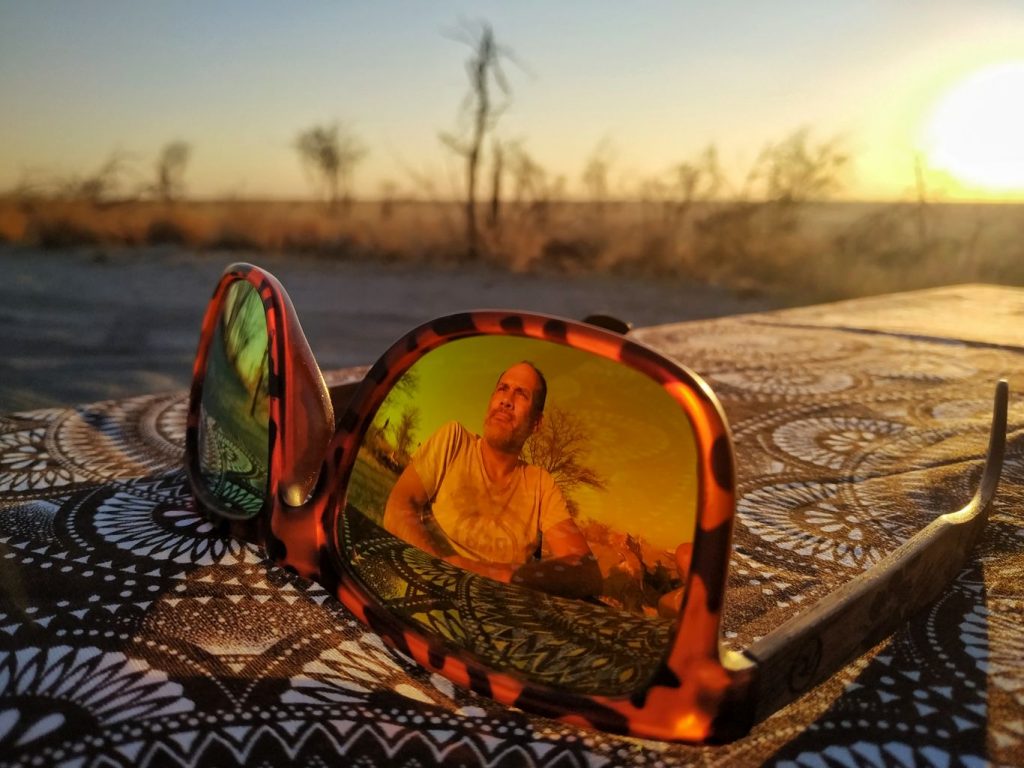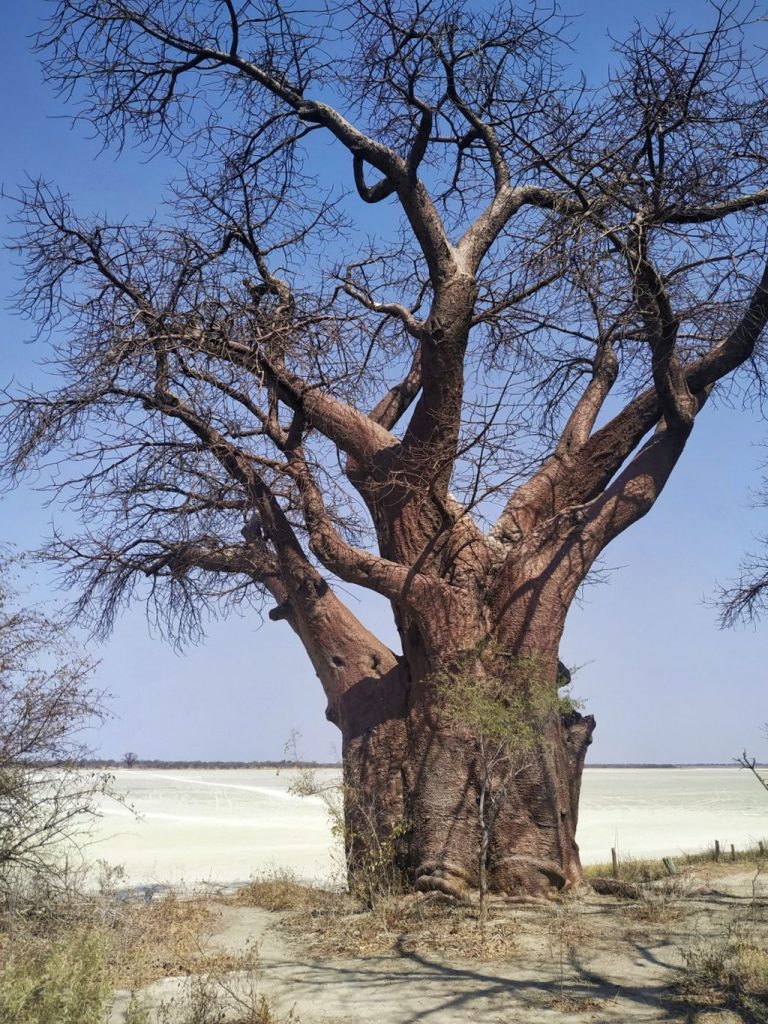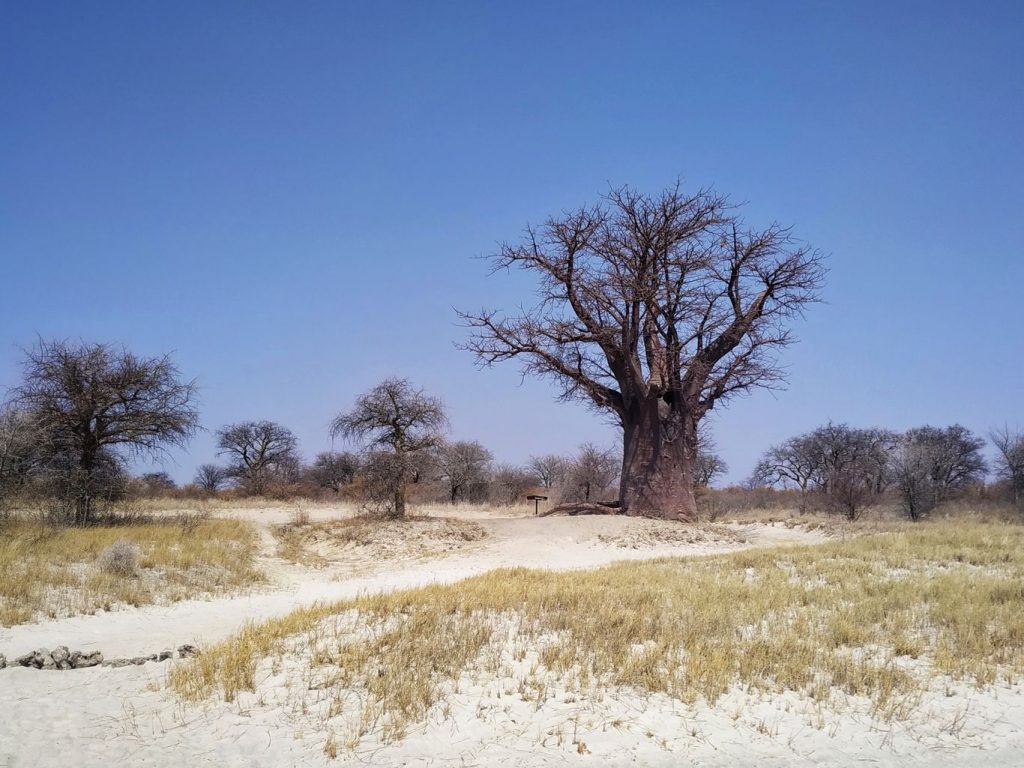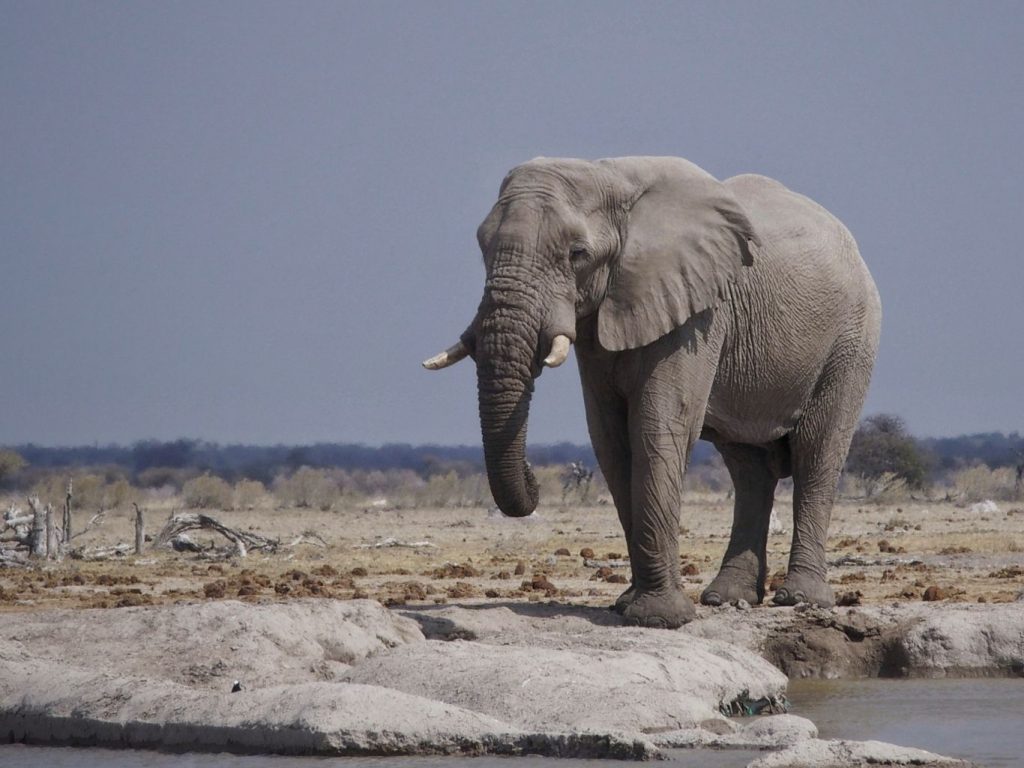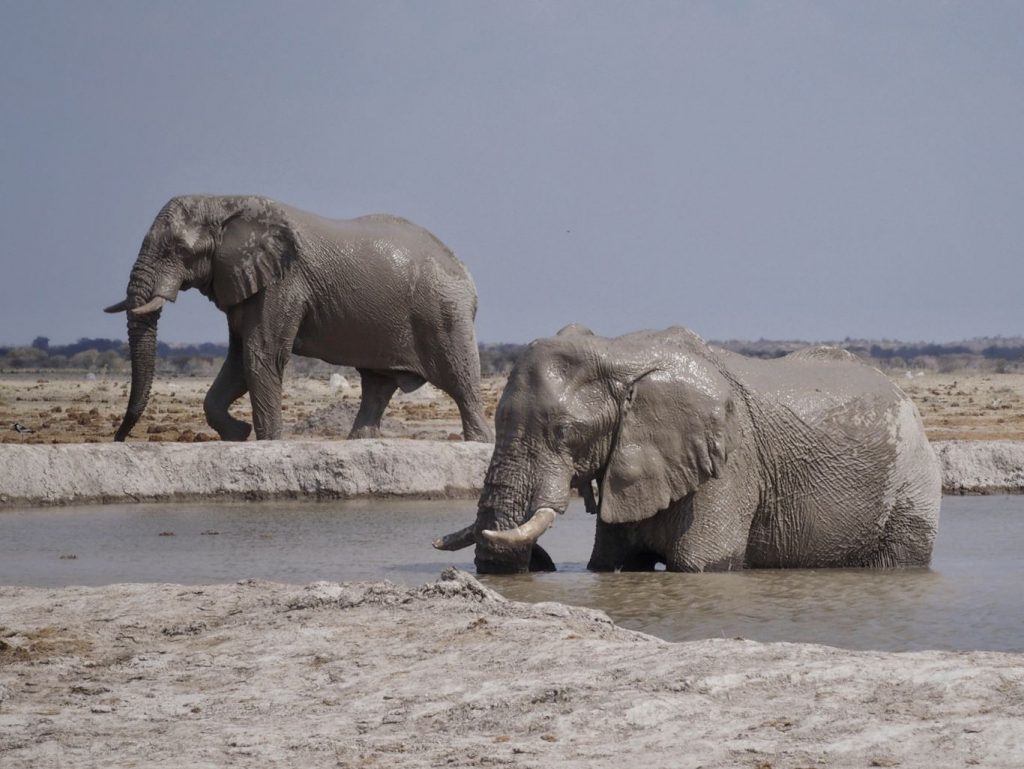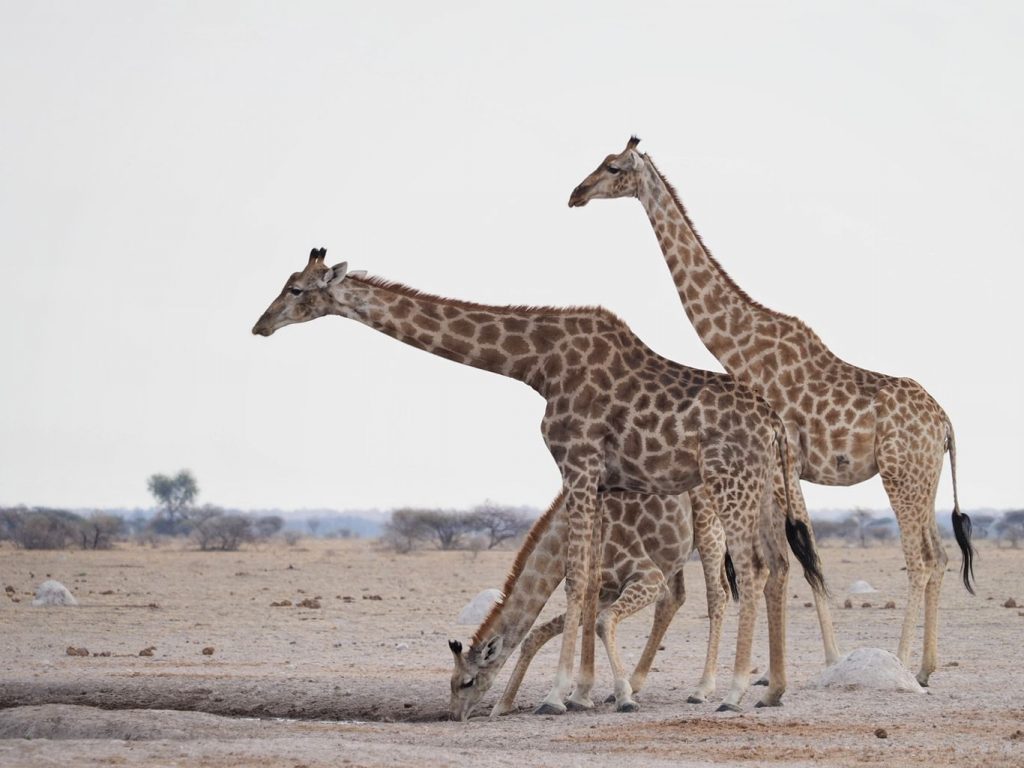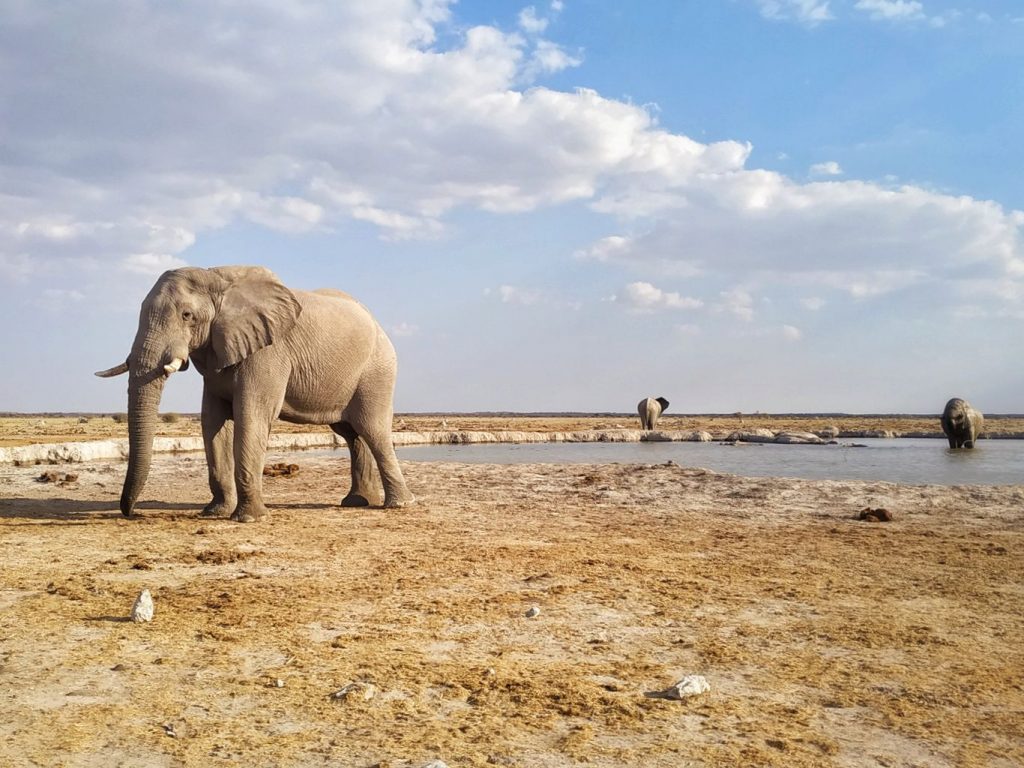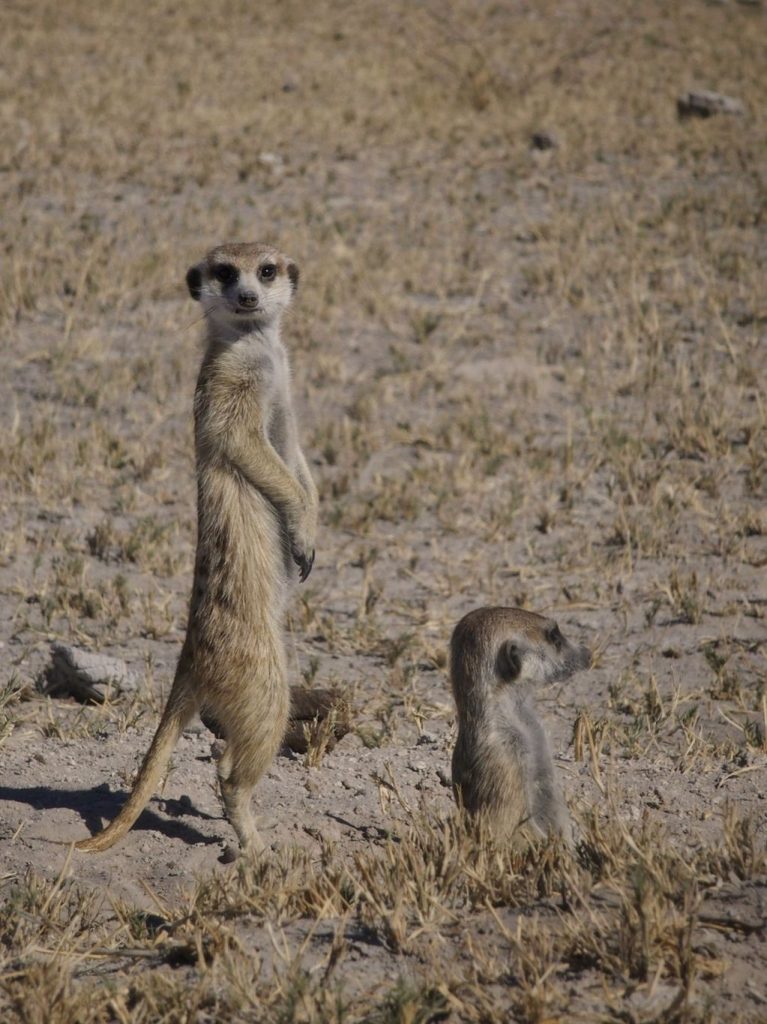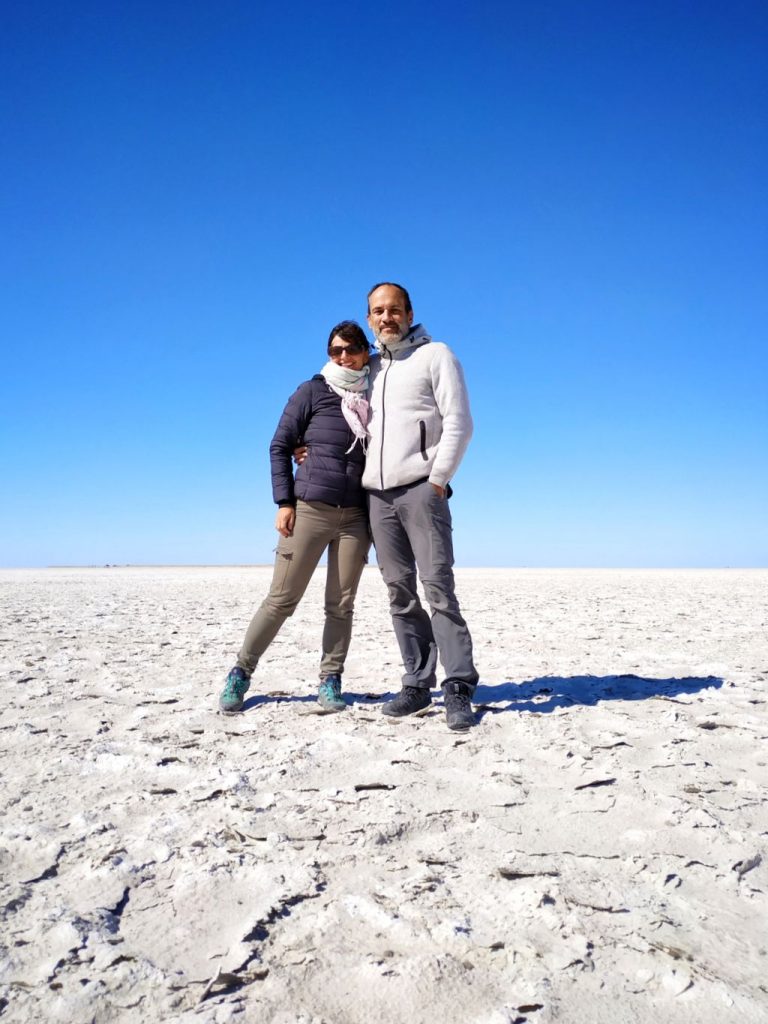With a proper hot shower and a nice bed, our one night stop in Rakops was invigorating. We had high expectations that we could resupply but the only available shops were small and their stock limited. We managed to buy some cereals for breakfast, few bananas and drinkable water as we would have to be self-sufficient again for the next days. Luckily, the gas station was not closed and we had our tanks filled up.
Makgadikgadi Pans National Park
We left our bungalow in the morning and drove along the A30 road to the Khumaga entrance of the Makgadikgadi Pans National Park. After about an hour of driving and the crossing of a dry riverbed, we were at the gate. Vervet monkeys were roaming the place, looking for scrap food in the bins. We paid our entrance and camping fees, I lowered the tyre pressure, shifted in 4×4 and drove into the park. We passed the campsites by the gate and quickly hit thick sand. We were driving on the ridge overlooking the Boteti river. The river normally flows all year around also it slims down in the dryer month of July and August. Well, this year the river was dry and the flow almost completely stopped, leaving only waterholes here and there. We were driving towards the hippo pool and were excited to finally see some zebras, kudus and wildebeests. Getting closer to the ridge we had a glimpse of a handful of elephants drinking at a waterhole. It didn’t take much more to decided us to drive down the sandy slope to the riverbed in search for more of those giants. On our way down, I thought it would be a challenge to get back out of this trap but decided we would have to figure this out later. Driving along the riverbed we were surrounded by zebras. Massive herds were drinking, more were coming down from our right. It was zebra rush hour and we were stuck in the traffic. We had never seen so many zebras in one place ever before, very impressive. Makgadikgadi is home to a crazy number of zebras. They migrate to the river during the dry season making it the second biggest migration after the wildebeests in the Masai Mara and Serengeti. After a while we decided to drive around the last zebras and stopped a bit further to watch a group of elephants drinking and bathing in a waterhole. Then it was time to think about leaving the place and try to drive back up to the ridge. The slope was steep and the sand was thick. I stopped at the bottom to engage the 4LO ratio and hit the accelerator, crossing my fingers I would not get stuck in the middle of it. The Toyota Hilux has quite a long hood and as a matter of fact you don’t see much when driving up steep slopes. With my field of view reduced to a patch of blue sky, I sped up, zigzagged through bushes and branches and in no time we were back on the ridge. My 4×4 driving confidence got a boost!
On our way down, I thought it would be a challenge to get back out of this trap but decided we would have to figure this out later. Driving along the riverbed we were surrounded by zebras. Massive herds were drinking, more were coming down from our right. It was zebra rush hour and we were stuck in the traffic. We had never seen so many zebras in one place ever before, very impressive. Makgadikgadi is home to a crazy number of zebras. They migrate to the river during the dry season making it the second biggest migration after the wildebeests in the Masai Mara and Serengeti. After a while we decided to drive around the last zebras and stopped a bit further to watch a group of elephants drinking and bathing in a waterhole. Then it was time to think about leaving the place and try to drive back up to the ridge. The slope was steep and the sand was thick. I stopped at the bottom to engage the 4LO ratio and hit the accelerator, crossing my fingers I would not get stuck in the middle of it. The Toyota Hilux has quite a long hood and as a matter of fact you don’t see much when driving up steep slopes. With my field of view reduced to a patch of blue sky, I sped up, zigzagged through bushes and branches and in no time we were back on the ridge. My 4×4 driving confidence got a boost!
We stopped in a unoccupied bush camp for lunch and to stretch our legs and back. This was not big news but driving on tracks in Botswana can be tiresome. Time was ticking and considering that our average speed in sand seemed to oscillate between 25 and 30 km/h we decided it would be wise to leave the Boteti river and head towards our campsite in the Njuca Hills some 60 kilometres to the East. With no surprise it took us 2 hours and a half to get there on sandy and heavily corrugated two spoor tracks. Our GPS actually died en route due to the vibrations. Luckily we had the map we were given at the park entrance and it was enough to reach the camp. Not much game to see in that part of the park but the vistas, simply fantastic, Africa as you imagine it. We were alone in the middle of the savannah, high yellow grass burned by the scorching sun with random acacias and palm trees dotting the horizon. Still we saw our first giraffe although some distance away. The camp didn’t disappoint, unfenced with a braai and a bucket shower. We were alone and that would be our home for the next 2 nights. We didn’t do much in Njuca Hills. We just sat there enjoying the vastness of the savannah, reading a book or napping in the breeze. Vee seized the occasion to try her bush bread recipe and prepared the dough for four small rolls. The random oryx were sometimes spotted on the horizon and soon the sun set as a bright red disk calling the day off. I lit up the braai to cook dinner and once done it was time to “bake” the bread. The result, although not perfect, was decent and quite yummy. A work in progress in a way.
We didn’t do much in Njuca Hills. We just sat there enjoying the vastness of the savannah, reading a book or napping in the breeze. Vee seized the occasion to try her bush bread recipe and prepared the dough for four small rolls. The random oryx were sometimes spotted on the horizon and soon the sun set as a bright red disk calling the day off. I lit up the braai to cook dinner and once done it was time to “bake” the bread. The result, although not perfect, was decent and quite yummy. A work in progress in a way.
Discovery of Nxai Pan
After a good day of rest it was time to hit the road again and we headed towards Nxai Pan National Park. Initially we wanted to camp couple nights in the park too but couldn’t secure a campsite there, the cons of travelling last minute. From Njuca Hills it took us under two hours to reach the entrance gate of Nxai Pan but the hardest portion of that stretch was to come. Nxai Pan is notorious for very (understand extremely) sandy tracks. We thought we had seen it all since entering Botswana but truth is, tracks in Nxai Pan are one notch above on the sandy scale. Add bad corrugations and you have the perfect recipe to drive at an amazing average speed of 20 km/h… We first stop at the Baines baobabs on the Kudiakam pan. You get a bunch of these majestic trees sitting next to the salt flat, a quiet location with an amazing vista yet very saddened to see these centuries old trees being carved with names, dates and other crap the like of “Jimmy loves Lucy”. How complicated is it to respect a place? From Baines baobabs we drove to Nxai pan itself. Not that far apart, it still took us an hour or so to reach it. Luckily when you reach the pan, the sand leaves space to salt flats and driving becomes much easier. Having only an afternoon to spend in the area we opted to stay around the main waterhole and wait for the animals to come get some water in this otherwise very dry environment. There we enjoyed elephants coming in droves to drink and bath. Herds were coming from all direction, sometimes surprising us from just behind the car. In the distance giraffes were waiting for their turn, slowly approaching the waterhole always cautious about who was there or not. Helmeted guinea fowl were splashing and drinking in smaller pools left behind by the elephants. At some point, panic took over the flock. Under attack, the birds dispersed in all directions, each running for its life. Descending from nowhere, an eagle flew low over the scared fowl and in no time had one poor bird in its talons. Life quickly resumed there after with birds returning to the waterhole and more elephants coming. Soon it was time to leave as we had some distance to cover to reach Gweta, our next destination. What a beautiful day in Nxai pan where we finally got to see elephants up close.
From Baines baobabs we drove to Nxai pan itself. Not that far apart, it still took us an hour or so to reach it. Luckily when you reach the pan, the sand leaves space to salt flats and driving becomes much easier. Having only an afternoon to spend in the area we opted to stay around the main waterhole and wait for the animals to come get some water in this otherwise very dry environment. There we enjoyed elephants coming in droves to drink and bath. Herds were coming from all direction, sometimes surprising us from just behind the car. In the distance giraffes were waiting for their turn, slowly approaching the waterhole always cautious about who was there or not. Helmeted guinea fowl were splashing and drinking in smaller pools left behind by the elephants. At some point, panic took over the flock. Under attack, the birds dispersed in all directions, each running for its life. Descending from nowhere, an eagle flew low over the scared fowl and in no time had one poor bird in its talons. Life quickly resumed there after with birds returning to the waterhole and more elephants coming. Soon it was time to leave as we had some distance to cover to reach Gweta, our next destination. What a beautiful day in Nxai pan where we finally got to see elephants up close.
Stop over in Gweta
We stayed at the Gweta Lodge for two nights. A nice place to drink a glass by the pool and relax. Gweta is centrally located in the middle of the pans and people drive to and from the Okavango delta are meeting there. The lodge is therefore a good place to share experiences and exchange tips on travelling in Botswana. That is actually where we knew that we would most likely not fly over the delta as we were told the water level was very low and the flight not worth it. While in Gweta, we opted to join a tour to see the meerkats. These little creatures are super cute and Vee loves them. Early in the morning, we hopped a land cruiser and headed towards Nwetwe pan. Chief, our driver, explained us that meerkats are always on the move, foraging for food, and are difficult to spot. So they actually have a farmer working for them whose job is to spot the meerkats early in the morning and to follow them. So we had to spot the guy who spots the meerkats. Are you following? At the end we got hold of the suricates and jumped out the vehicle to observe them from up close. some had really no interest in us continuing to look for food while others stopped for a while and observed us from a distance. Suricates are indeed funny and super cute. After some time with them we moved to the pan. That one is really impressive. It extends to the horizon with nothing but a flat white surface like an inner sea of milk. You can drive across the pan in the driest months but you should stick to existing tracks if you want to avoid bad surprises as pockets of water or soft mud can remain under the surface. The tour was nice but overpriced. I would definitely not recommend it as a must-do and will leave it to whoever visits the region to decides if they want to add it to their circuit. Leaving the central Kalahari region behind us, we drove one last time through the pans on road A3 keeping an eye on potholes and elephants crossing, and arrived in Maun just in time for lunch.
Leaving the central Kalahari region behind us, we drove one last time through the pans on road A3 keeping an eye on potholes and elephants crossing, and arrived in Maun just in time for lunch.
Photo Gallery
